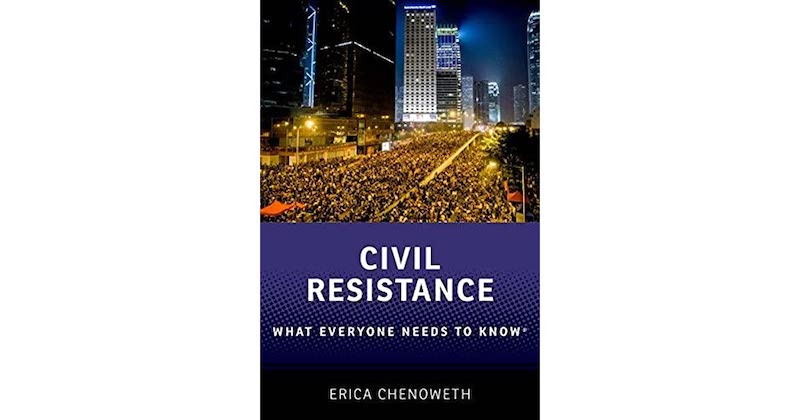Political violence and the denial of democratic rights have been the norm in American history, from slavery, Jim Crow, and Indian removal to the harsh repression of workers, immigrants, political dissenters, and sexual and gender minorities. But social movements, especially the Black freedom struggle, developed a sophisticated repertoire of techniques of nonviolent resistance against authoritarianism, borrowing from abroad and inventing new approaches that have been copied across the world. Because of their success, organizers have practiced in a context of formally democratic processes and institutions for more than a half-century since Congress passed the Voting Rights Act. But now, amid a global authoritarian resurgence, we in the US are engaged in what is likely to be a decade-long effort to preserve and expand multi-racial democracy. If we are to succeeed, we need to renew our own proud lineage of nonviolent resistance and learn from the history of popular movements in other countries that have prevailed against authoritarianism.
Fortunately, the new book Civil Resistance: What Everyone Needs to Know by Harvard professor Erica Chenoweth addresses that need brilliantly. Chenoweth is perhaps the world’s leading scholar on authoritarianism, and Civil Resistance distills an immense body of research. Chenoweth’s most celebrated achievement, created with political scientist Maria J. Stephan, is a vast data set that allows for comparative analysis of 627 revolutionary campaigns around the world, both violent and nonviolent, between 1900 and 2019. The central finding, which many may find surprising, is that nonviolent campaigns have historically been twice as successful as violent insurgencies at achieving their goals. Therefore, the choice of nonviolence is a strategic one rather than simply one about morality.
Part of Oxford University Press’s “What Everyone Needs to Know” series, the book is composed of several dozen short sections, each answering a common question, such as “What civil resistance tactics are most — and least — successful?” “Do violent flanks undermine nonviolent campaigns?” and “What is smart repression, and how are movements adapting to it?” Full of practical lessons and inspiring examples from countries worldwide, Chenoweth’s book is the closest thing we in the US have to a how-to guide for defanging Trumpism. Many of the campaigns Chenoweth profiles aimed to defeat authoritarian regimes that had already taken power, but the insights are broadly relevant to people who hope to prevent autocrats from winning power in the first place.
Chenoweth writes that many near-synonyms—including “people power,” “nonviolent struggle,” and “strategic nonviolence”—might have been suitable alternative titles for the book. But they chose the term “civil resistance,” which was coined in the early 20th century by Mahatma Gandhi, who preferred it because it avoided connotations of passivity, on the one hand, and militancy, on the other. Chenoweth defines civil resistance as a method of active conflict in which unarmed people use a variety of coordinated, noninstitutional methods—strikes, protests, demonstrations, boycotts, alternative institution building, and many other tactics—to promote change without harming or threatening to harm an opponent. In English, the term “civil” derives from the Latin civis, meaning “citizen.” In contemporary usage, the term “civil” conjures a sense of public responsibility, in which people collectively assert their rights and needs on behalf of their communities. The term “resistance” derives from the Latin resistere. Sistere is a strong form of the verb stare, “to stand.” The prefix re adds intensity to the word. Through civil resistance, people from all walks of life come together to take a stand, with great intensity and strength, and demand justice and accountability of others.
Contrary to widespread myths, Chenoweth writes that civil resistance is not “passive, weak, or ineffective,” nor does it “require the adversary to care about morality.”
According to Chenoweth, the success of civil resistance movements depends on four factors. First, they must become large and diverse. Chenoweth coined the “3.5% rule,” according to which “no revolutions have failed once 3.5% of the population has actively participated in an observable peak event like a battle, a mass demonstration, or some other form of mass noncooperation.” Although a 2019 paper did find a couple of exceptions — in Brunei and Bahrain — the rule still holds, but as “a rule of thumb [rather] than an iron law.”
Second, civil resistance must “shift the loyalties of people within” what activist and scholar George Lakey dubbed the adversary’s “pillars of support,” the groups and institutions the regime depends on to maintain power, such as security forces, economic elites, bureaucrats, media, religious authorities, educational institutions, cultural figures, organized labor, and civil society organizations. Winning defections from those pillars weakens and can ultimately topple the regime. This may involve moral appeals, but more often it requires changing the self-interested calculations of important players, for example by inflicting real economic harm on business elites, causing them to break with the regime — an important tactic in South Africa’s anti-apartheid struggle.
In the current US context, the point about defections is critical. While it’s essential to mobilize the pro-democracy base, we also need to create on-ramps to draw in people who are disengaged, ideologically inconsistent, or even soft supporters of Trump. In recent years, democratic forces have gravitated toward a culture of mobilization, which seeks to rally the already persuaded. What we need instead is to revive a culture of recruitment, which engages people who are not already converted. We also need to move beyond merely pressuring elected officials and turn our energies toward challenging corporations, which often enable or actively support the authoritarian insurgency. (An excellent example of this approach is the Defend Black Voters campaign in Michigan.)
Third, civil resistance movements benefit from employing a wide variety of tactics, including unexpected ones — not just demonstrations. As Chenoweth puts it, “a strike, combined with collective support from a broad base of a population, can be truly threatening to a regime’s grip on power.” In 1942, when Vidkun Quisling, head of the Nazi’s puppet government in Norway, attempted to Nazify school curricula, 83% of teachers “refused, went on strike, or continued teaching underground.” When Quisling retaliated by arresting teachers and sending 500 to a concentration camp, children’s parents rallied to their cause, ultimately forcing Quisling to back down.
In the US, protest has become a default response to outrages, but Chenoweth argues that other forms of collective action are more effective. Nonviolent movements are not only or even mainly successful because of mass protest. Protests can grab headlines but may not do anything to challenge the functioning of authoritarian regimes. And protests can become predictable. Chenoweth’s research shows that successful movements use multiple techniques, “like demonstrations, strikes, stay-aways, blockades, the creation of alternative institutions, and other forms of noncooperation — sequenced intentionally to dislodge entrenched power.”
Fourth, successful civil resistance movements maintain “discipline and resilience in the face of repression,”
. . . sustaining mass involvement even as the government cracks down on them violently. What’s most important is remaining organized, no matter what the regime throws at them—neither fighting back with their own counterviolence or reacting or retreating in disarray. The movements that manage to achieve this usually have clear organizational structures; succession plans in place in case a leader is imprisoned, killed, or otherwise sidelined; and contingency plans for how to respond when repression escalates. It also involves keeping a broad range of people, in mass numbers, involved even while coming under fire, because cracking down on a highly diverse movement is more likely to backfire against the opponent. It is much tougher (though not impossible) for regimes to get away with targeting civilians who are considered mainstream or even close to the regime’s social circles than it is to target smaller-scale crowds who are not perceived as representative of the society as a whole.
Chenoweth stresses that nonviolent campaigns are not spontaneous — they are deliberate and premeditated and require a high level of coordination among key civil society actors. This point seems particularly relevant in the US, where there are vast numbers of disparate groups organized around issues and constituencies but not yet a central, ongoing hub for the defense of democracy.
Chenoweth points to the importance of humor in successful nonviolent campaigns. “One way to show that an adversary can’t control all of the people all of the time is to joke about him . . . . [H]umor can bring levity, cheerfulness, and a carnivalesque mood to an otherwise antagonistic, grim, or grave situation. . . . Festive events can attract large numbers of people seeking refuge from monotony, hopelessness, and betrayal.” Curiously, Civil Resistance does not mention a tactic Chenoweth has discussed elsewhere (as in their recent interview on the Hidden Brain podcast) — what may be the most hilarious act of civil resistance of all time. When the Moroccan government forbade separatists from flying the flag of Western Sahara, the independence activists put on a rally and released dozens of feral cats, each with a Western Sahara flag tied to its tail. To enforce the “no flag” order, the state police were thus forced to chase haplessly after the cats. In the US context, we might consider how to apply this lesson by working with a broader range of mobilizing emotions. Rather than defaulting to righteous anger all the time, we could use tactics that inspire laughter, hope, and joy — emotions that counter fear, enliven movements, and attract more people to them.
Another shift suggested by Chenoweth’s work is to reconsider the historic split between organizations engaged in mutual aid, cooperative, and service work, on the one hand, and those working to change oppressive systems, on the other. It’s intriguing to consider how they might be woven back together. Chenoweth stresses the importance of parallel institutions, like mutual aid, coops, and alternative news outlets, in sustaining movements. They write, “The nonviolent resistance scholar and practitioner Michael Nagler argues that parallel institutions can help a fairly disorganized nonviolent campaign coalesce around common objectives. Parallel institutions can also help movements to survive when crackdowns become too severe and dissidents must go underground. Nagler argues that parallel institutions can give dissidents less risky options than direct and overt forms of resistance that might get them arrested, attacked, or killed.”
A final provocation for US activists that emerges out of Chenoweth’s work is about how to spark the emergence of movement uprisings. They argue that “the most consistent and influential predictor of nonviolent uprising was a country’s human rights record.” As political far-right violence inevitably escalates, we will have openings to galvanize counter-reactions that can be planned for in advance.
The book’s closing chapter, “The Future of Civil Resistance,” paints a complex picture of the era of history we’re entering. On the one hand, the number of nonviolent revolutions has risen steadily since 1900, and the period between 2010 and 2019 witnessed more than any previous decade.
Moreover, nonviolent resistance continues to prove far more successful than violent revolution and is, according to the most recent data, more than three times more likely to accomplish a movement’s goals. However, the success rates of all revolutions, violent and nonviolent, have decreased in recent years.
Chenoweth attributes the declining success rate to a variety of factors, including that nonviolent movements have become somewhat smaller over time. Since 2010, the average peak participation has declined to 1.3%, far less than the 3.5% threshold that Chenoweth found predicts success. In recent times, movements have also tended to over-rely on mass demonstrations at the expense of other techniques of mass noncooperation. The dramatic increase in the use of social media has obvious advantages but disadvantages, too, notably reducing the capacity to strategize and plan. Nonviolent movements have also been accompanied more in recent times by violent fringes, which undermine public support and legitimize repression. Finally, oppressive regimes have adapted to movements, developing techniques of “smart repression,” such as high-tech surveillance, social media disinformation, and infiltrating resistance movements.
Chenoweth’s work is of crucial importance for US activists today. Extrapolating from Chenoweth’s deep analysis, we can identify several significant shifts that will be necessary to sustain a long battle against authoritarianism, including giving more emphasis to recruitment and base-building over episodic mobilization; expanding the toolkit of noncooperation beyond protests to other forms of disruption and the development of alternative institutions; thinking strategically about how to weaken the pillars of support for authoritarian politics; training thousands of people in the practices of nonviolent resistance; and developing new ways to coordinate and plan activity across the vast numbers of groups working on disparate issues.
None of this will be easy. We are at a particularly low point energetically in the US. Years of fighting Trumpism combined with the disappointments of the Biden years, the ongoing COVID crisis, and rising climate grief have resulted in a pervasive malaise. But it was not so long ago that organizers rallied successfully to save democracy. The level of coordination and determination we demonstrated in the 2020 election cycle was extraordinary. Many of the lessons Chenoweth distills from the history of civil resistance movements were applied in an exemplary fashion by groups across the country. While canvassing in Philadelphia in 2020, we were moved to see UNITE HERE organizers training hundreds of volunteers and rank-and-file union members in the principles of nonviolence as we prepared for post-election attacks on ballot counting sites. We will need to marshal that kind of savvy, coordination, discipline, and creativity on a massive scale and sustain it for a decade or more. Chenoweth points to the need for hubs to coordinate pro-democracy work across organizations, issues, and geographies and to the imperative of large-scale trainings and popular education to prepare everyday people for what may be coming.
Sadly, there’s no book of magic spells with instructions for how to cast out the demons of authoritarianism. But Erica Chenoweth’s book is the user manual we need for the long and difficult struggle ahead of us.


